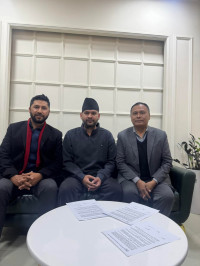Opinion
Madhes drift
We should explore forces that have connected and strained relationship between the Madhes and Pahad
Bicram Rijal
Last month, the Constitution of Nepal 2015 was promulgated by an overwhelming majority eight years after the formation of the first Constituent Assembly (CA). This much-awaited document was expected to end the political stalemate in the country. But unfortunately, that did not happen. The disgruntled communities, mainly Madhesis and Tharus are protesting against the discriminatory clauses of the new constitution and the problematic delineation of the boundaries of the federal provinces. To date, more than 40 people have already lost their lives due to the ongoing agitation in the southern plains, first started by Tharus and then continued by Madhesis. This has rubbed salt into the nation’s wounds that is still coming to terms with the horrible memories of the twin earthquakes.
However, unlike the 2007 Madhes Movement, the ongoing agitation in the southern plains seems to have greatly divided the people. Newspapers, as well as social and online media platforms are inundated with opinions, comments and political commentaries for and against the ongoing protests in Madhes-Tarai. The discussions are so polarised that those supporting the protests are perceived as ‘Indian agents’, ‘anti-national elements’ and messiah of Indian interventionism. Those who oppose the movement are termed pseudo-nationalists, anti-progress and benefactors of Bahun-Chhetri domination.
Questioning the media
Many ‘netizens’ also question the ethics and professionalism of journalists and impeach the credibility of the media. Journalists have been accused of not being able to distinguish the fine line between facts and fabrications, between what really happens on the ground and what is represented afterwards.
In the initial stages of the agitation, the Madhesis were angry at the mainstream Kathmandu-based media for allegedly not publishing the photos of rallies and sit-in protests which the former claimed was attened by thousands of peoplde. This raised several questions. How do media represent the reality and how should they do that? Do journalists and other opinion makers, including social scientists have an ethical responsibility to be critical and reflect on their own actions and interpretations? Should they not ask themselves if their actions fuel or help to solve the crisis? Perhaps, the accounts of the ongoing political crisis should also delve into these questions as journalists have better access to the ground zero than others.
So, it is important to explore the ways journalists are engaging with the current crisis, including their complicity. A pattern can easily be established if one has been keeping a tab on the opinion pieces in the national and international media. Those supporting the Madhesi cause, for instance, perceive Kathmandu as a homogeneous entity. They think its inhabitants are either elites or the powerful or those belonging to dominant social groups. Similarly, most of the opinion pieces in the mainstream Nepali media blame India for fueling the ongoing crisis in the Madhes-Tarai. Though most of them recognise the historical exclusion and marginalisation of the Madhesis, Tharus, women, and ethnic groups, they are skeptical about the genesis and intention of the agitations in the Madhes. In the last two weeks, since the start of the ‘unofficial’ economic blockade, the focus has shifted from the Madhesis’ and Tharus’ grievances and demands to Indian intentions and implications of the blockade.
The unintended consequence of such a shift is that it keeps us from seeing the source of our problems. The regional and global context of the problem cannot and should not be underestimated in a globally-connected world. But we should not render our complicities, responsibilities, actions and reactions invisible while
doing so.
Not a fixed entity
One of the problems in the commentaries on the ongoing crisis in Madhes-Tarai is that they treat the Madhes as a fixed and unitary geographic region. It ignores the diversity of the people and their heterogeneous lives and cultural practices. There is a need to represent the Madhes not only as a far-stretch of flat lands, but also people’s different ways of being and becoming in their everyday life.
Further, it is problematising the imaginings of fixed, primordial, naturalised and singular identity and bringing to fore the multiple subjectivities and identities of the Madhes located in different socio-historical and politico-economic contexts. Such a move has lead us to the following questions: How has Madhes-Tarai formed and transformed over time? What does Madhes-Tarai involve? What kinds of identities and embodied social and cultural practices come to our mind while thinking and talking about Madhes-Tarai? And, in what ways are they similar to or different from other ways of being compared to Pahadi or Himali?’
Overcoming binaries
The recent flood of social commentaries on the ongoing turmoil is guided by a false dichotomy between the Madhes and Pahad. It builds on the misapprehension that the Madhes-Tarai and Pahad are necessarily oppositional categories, which do not share anything in common. In reality, the Madhes is linked with Pahad and Himal and vice-versa in many different
ways: geographically, socially, economically, politically, culturally
and materially.
So, while the demand for proportional representation of Madhesis and other agitated and marginalised groups cannot and should not be denied, building a ‘pure’ Madhes or ethnic province wrongly implies two things. First, human identities and cultural practices are fixed, unchangeable, and limited to a definite territorial boundary. Second, the separation of Madhes from Pahad or vice versa is a solution. But, the movement of people, cultures, and ideas cannot be locked into a territory in an increasingly globalised world. So, there cannot be any ‘pure’ Madhesi, Pahadi, or an ethnic province in the true sense of the term.
Instead of taking the Madhes and Pahad or Himal as binary oppositions, we should explore the forces that have both historically connected these different social geographies and strained their relationships. Our analyses should shed light on the processes of marginalisation and exclusion as well as of social harmony and coexistence. This does not mean that we should pay less heed to the political demands of the socially excluded and marginalised communities. Rather, it implies that we understand the holistic context that unites and divides us as a nation at once.
Rijal is a PhD Candidate in Anthropology at Simon Fraser University, Canada, and currently doing his fieldwork in Nepal




 11.12°C Kathmandu
11.12°C Kathmandu










%20(1).jpg&w=300&height=200)

